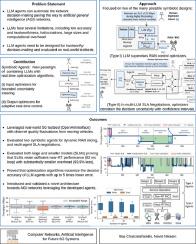Symbiotic agents: A novel paradigm for trustworthy AGI-driven networks
IF 4.6
2区 计算机科学
Q1 COMPUTER SCIENCE, HARDWARE & ARCHITECTURE
引用次数: 0
Abstract
Large Language Model (LLM)-based autonomous agents are expected to play a vital role in the evolution of 6G networks, by empowering real-time decision-making related to management and service provisioning to end-users. This shift facilitates the transition from a specialized intelligence approach, where artificial intelligence (AI) algorithms handle isolated tasks, to artificial general intelligence (AGI)-driven networks, where agents possess broader reasoning capabilities and can manage diverse network functions. In this paper, we introduce a novel agentic paradigm that combines LLMs with real-time optimization algorithms towards Trustworthy AI, defined as symbiotic agents. Optimizers at the LLM’s input-level provide bounded uncertainty steering for numerically precise tasks, whereas output-level optimizers supervised by the LLM enable adaptive real-time control. We design and implement two novel agent types including: (i) Radio Access Network (RAN) optimizers, and (ii) multi-agent negotiators for Service-Level Agreements (SLAs). We further propose an end-to-end architecture for AGI-driven networks and evaluate it on a 5G testbed capturing channel fluctuations from moving vehicles. Results show that symbiotic agents reduce decision errors fivefold compared to standalone LLM-based agents, while smaller language models (SLM) achieve similar accuracy with a 99.9 % reduction in Graphical Processing Unit (GPU) resource overhead and in near-real-time (near-RT) loops of . A multi-agent demonstration for collaborative RAN on the real-world testbed highlights significant flexibility in service-level agreement and resource allocation, reducing RAN over-utilization by approximately 44 %. Drawing on our findings and open-source implementations, we introduce the symbiotic paradigm as the foundation for next-generation, AGI-driven networks-systems designed to remain adaptable, efficient, and trustworthy even as LLMs advance. A live demo is presented here https://www.youtube.com/watch?v=WQv61z1deXs&ab\_channel=BubbleRAN

共生代理:可信赖agi驱动网络的新范例
基于大型语言模型(LLM)的自主代理有望在6G网络的发展中发挥重要作用,为最终用户提供与管理和服务提供相关的实时决策。这种转变促进了从专门的智能方法(人工智能(AI)算法处理孤立任务)到人工通用智能(AGI)驱动的网络的过渡,其中代理具有更广泛的推理能力并可以管理各种网络功能。在本文中,我们引入了一种新的代理范式,将llm与实时优化算法结合起来,实现可信赖的人工智能,定义为共生代理。LLM的输入级优化器为数字精确任务提供有界不确定性转向,而由LLM监督的输出级优化器实现自适应实时控制。我们设计并实现了两种新的代理类型,包括:(i)无线接入网络(RAN)优化器,以及(ii)服务水平协议(sla)的多代理谈判者。我们进一步提出了一种用于agi驱动网络的端到端架构,并在5G测试平台上对其进行了评估,该平台捕获了移动车辆的信道波动。结果表明,与独立的基于llm的代理相比,共生代理减少了五倍的决策错误,而较小的语言模型(SLM)在图形处理单元(GPU)资源开销和82ms的近实时(近rt)循环中减少了99.9%,达到了类似的准确性。在实际测试平台上,协作RAN的多智能体演示突出了服务水平协议和资源分配方面的显著灵活性,将RAN的过度利用率降低了约44%。根据我们的发现和开源实现,我们介绍了共生范式,作为下一代agi驱动网络的基础——即使llm进步,系统也要保持适应性、效率和可信赖性。这里提供了一个实时演示https://www.youtube.com/watch?v=WQv61z1deXs&ab\_channel=BubbleRAN
本文章由计算机程序翻译,如有差异,请以英文原文为准。
求助全文
约1分钟内获得全文
求助全文
来源期刊

Computer Networks
工程技术-电信学
CiteScore
10.80
自引率
3.60%
发文量
434
审稿时长
8.6 months
期刊介绍:
Computer Networks is an international, archival journal providing a publication vehicle for complete coverage of all topics of interest to those involved in the computer communications networking area. The audience includes researchers, managers and operators of networks as well as designers and implementors. The Editorial Board will consider any material for publication that is of interest to those groups.
 求助内容:
求助内容: 应助结果提醒方式:
应助结果提醒方式:


